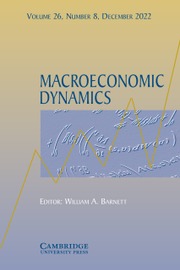Crossref Citations
This article has been cited by the following publications. This list is generated based on data provided by
Crossref.
Gylfason, Thorvaldur
1999.
Exports, Inflation and Growth.
World Development,
Vol. 27,
Issue. 6,
p.
1031.
Gylfason, Thorvaldur
2000.
Resources, Agriculture, and Economic Growth in Economies in Transition.
SSRN Electronic Journal,
Gylfasonabc, Thorvaldur
2000.
Fix or flex? Alternative exchange rate regimes in an era of global capital mobility.
The North American Journal of Economics and Finance,
Vol. 11,
Issue. 2,
p.
173.
Matthiasson, Thorolfur
2000.
The Icelandic Debate on the Case For a Fishing Fee: A Non-Technical Introduction.
SSRN Electronic Journal,
Matthı́asson, Thórólfur
2001.
The Icelandic debate on the case for a fishing fee: a non-technical introduction.
Marine Policy,
Vol. 25,
Issue. 4,
p.
303.
Gylfason, Thorvaldur
and
Herbertsson, Tryggvi Thor
2001.
Does inflation matter for growth?.
Japan and the World Economy,
Vol. 13,
Issue. 4,
p.
405.
Sachs, Jeffrey D.
and
Warner, Andrew M.
2001.
The curse of natural resources.
European Economic Review,
Vol. 45,
Issue. 4-6,
p.
827.
Gylfason, Thorvaldur
2001.
Regionalism in Europe.
Vol. 4,
Issue. ,
p.
147.
Gylfason, Thorvaldur
2001.
Natural resources, education, and economic development.
European Economic Review,
Vol. 45,
Issue. 4-6,
p.
847.
Torvik, Ragnar
2002.
Natural resources, rent seeking and welfare.
Journal of Development Economics,
Vol. 67,
Issue. 2,
p.
455.
Gylfason, Thorvaldur
2002.
Fostering Sustainable Growth in Ukraine.
p.
48.
Paavola, Jouni
2002.
Environment and Development: Dissecting the Connections.
Forum for Development Studies,
Vol. 29,
Issue. 1,
p.
5.
Elı́asson, Lúdvı́k
and
Turnovsky, Stephen J.
2004.
Renewable resources in an endogenously growing economy: balanced growth and transitional dynamics.
Journal of Environmental Economics and Management,
Vol. 48,
Issue. 3,
p.
1018.
Papyrakis, Elissaios
and
Gerlagh, Reyer
2004.
Resource-Abundance and Economic Growth in the U.S..
SSRN Electronic Journal,
Ciccantell, Paul S.
and
Smith, David A.
2005.
Nature, Raw Materials, and Political Economy.
Vol. 10,
Issue. ,
p.
1.
Barbier, Edward B.
2005.
Natural Resources and Economic Development.
Falkinger, Josef
and
Grossmann, Volker
2005.
Institutions and Development: The Interaction Between Trade Regime and Political System.
Journal of Economic Growth,
Vol. 10,
Issue. 3,
p.
231.
Matsen, Egil
and
Torvik, Ragnar
2005.
Optimal Dutch disease.
Journal of Development Economics,
Vol. 78,
Issue. 2,
p.
494.
Doucouliagos, Chris (Hristos)
and
Paldam, Martin
2005.
The Aid Effectiveness Literature - The Sad Result of 40 Years of Research.
SSRN Electronic Journal,
Antoci, Angelo
2005.
Environmental Resources Depletion and Interplay Between Negative and Positive Externalities in a Growth Model.
SSRN Electronic Journal,

